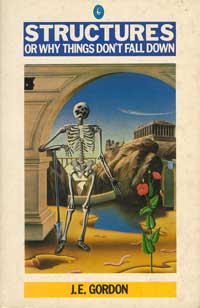
Why Things Don't Fall Down
J. E. Gordon
London, 1978.
Likeable though The New Science of Strong Materials is, this is the better book, and covers a wide range of matters, from ships to sausages:
"the circumferencial stress in the wall of a cylindrical pressure vessel is twice the longitudinal stress... One consequence of this must have been observed by everyone who has ever fried a sausage. When the filling inside the sausage swells and the skin bursts, the slit is almost always longitudinal." (p.121)
You may look differently on trees, as well as sausages, after reading this book. How do trees manage to sway without breaking in strong winds?
"the tree manages to grow in such a way that the outer wood is normally in tension (to the extent of something over 2000 psi or 14 MN/m2), while the middle of the tree, by way of compensation, is in compression." (p.282)
Gordon's illuminating book is referred to throughout THE FULLER MAP, as in Energy of Production and High Tensile Steel.
There are many anecdotes to enjoy, such as this one about a cook on a big freighter who spotted a crack in his galley floor. He reported it, but was told to make the breakfast and not worry about it.
"The cook, however, was of a scientific turn of mind, and, when he had disposed of breakfast, he got some paint and marked the end of the crack and painted the date against the mark. Next time the ship went through some bad weather the crack extended a few inches and the cook painted in a new mark and a new date. Being a conscientious man he did this several times.
When the ship eventually broke in two, the half which was salvaged and towed into port happened to be the side on which the cook had painted the dates, and this [...] constitutes the best and most reliable record we have of the progress of a large crack of sub-critical length." (p.105)
© Paul Taylor 2000